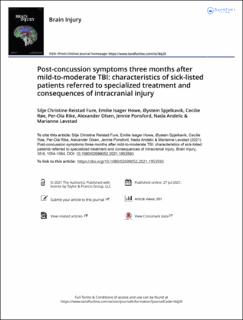| dc.contributor.author | Fure, Silje Christine Reistad | |
| dc.contributor.author | Howe, Emilie | |
| dc.contributor.author | Spjelkavik, Øystein | |
| dc.contributor.author | Røe, Cecilie | |
| dc.contributor.author | Rike, Per-Ola | |
| dc.contributor.author | Olsen, Alexander | |
| dc.contributor.author | Ponsford, Jennie | |
| dc.contributor.author | Andelic, Nada | |
| dc.contributor.author | Løvstad, Marianne | |
| dc.coverage.spatial | Norway | en_US |
| dc.date.accessioned | 2021-10-01T14:18:14Z | |
| dc.date.available | 2021-10-01T14:18:14Z | |
| dc.date.created | 2021-07-28T21:33:06Z | |
| dc.date.issued | 2021-07-27 | |
| dc.identifier.issn | 0269-9052 | |
| dc.identifier.issn | 1362-301X | |
| dc.identifier.uri | https://hdl.handle.net/11250/2787083 | |
| dc.description.abstract | Objective: To present pre-injury, injury-related, work-related and post-injury characteristics, and to compare patients with and without traumatic intracranial abnormalities, in a treatment-seeking sample with persistent post-concussion symptoms (PPCS) after mild-to-moderate TBI. Methods: Cross-sectional design in the context of a specialized TBI outpatient clinic. Eligible patients were aged 18–60 years, employed ≥ 50% at time of injury, and sick listed ≥ 50% at inclusion due to PPCS. Data were collected 8–12 weeks after injury through review of medical records, semi-structured interviews, questionnaires, and neuropsychological screening. Results: The study included 116 patients, of whom 60% were women, and predominantly white-collar workers in full-time positions. Ninety-four percent had a mild TBI, and 23% had intracranial abnormalities. The full sample reported high somatic, emotional, and cognitive symptom burden, and decreased health-related quality of life. Patients with normal CT/MRI results reported higher overall symptom burden, while patients with intracranial abnormalities had worse memory function. Conclusion: Injury severity and traumatic intracranial radiological findings should not be the sole ground for planning of rehabilitation service provision in patients with PPCS, as subjective complaints do not necessarily co-vary with these variables. | en_US |
| dc.description.sponsorship | The Research Council of Norway (256689/H10) provided funding. | en_US |
| dc.language.iso | eng | en_US |
| dc.publisher | Routledge | en_US |
| dc.relation.ispartofseries | Brain Injury;Volume 35, 2021 - Issue 9 | |
| dc.rights | Attribution-NonCommercial-NoDerivatives 4.0 Internasjonal | * |
| dc.rights.uri | http://creativecommons.org/licenses/by-nc-nd/4.0/deed.no | * |
| dc.subject | Traumatic brain injuries | en_US |
| dc.subject | Concussions | en_US |
| dc.subject | Persistent post-concussion symptoms | en_US |
| dc.subject | Post-concussive symptoms | en_US |
| dc.subject | Post-concussion symptom questionnaires | en_US |
| dc.subject | The Rivermead Post-Concussion Symptoms Questionnaire | en_US |
| dc.title | Post-concussion symptoms three months after mild-to-moderate TBI: characteristics of sick-listed patients referred to specialized treatment and consequences of intracranial injury | en_US |
| dc.type | Peer reviewed | en_US |
| dc.type | Journal article | en_US |
| dc.description.version | publishedVersion | en_US |
| dc.rights.holder | © 2021 The Author(s). | en_US |
| cristin.ispublished | true | |
| cristin.fulltext | original | |
| cristin.qualitycode | 1 | |
| dc.identifier.doi | https://doi.org/10.1080/02699052.2021.1953593 | |
| dc.identifier.cristin | 1922920 | |
| dc.source.journal | Brain Injury | en_US |
| dc.source.volume | 35 | en_US |
| dc.source.issue | 9 | en_US |
| dc.source.pagenumber | 1-11 | en_US |
| dc.relation.project | Norges forskningsråd: 256689 | en_US |
| dc.relation.project | Norges forskningsråd: 272789 | en_US |

